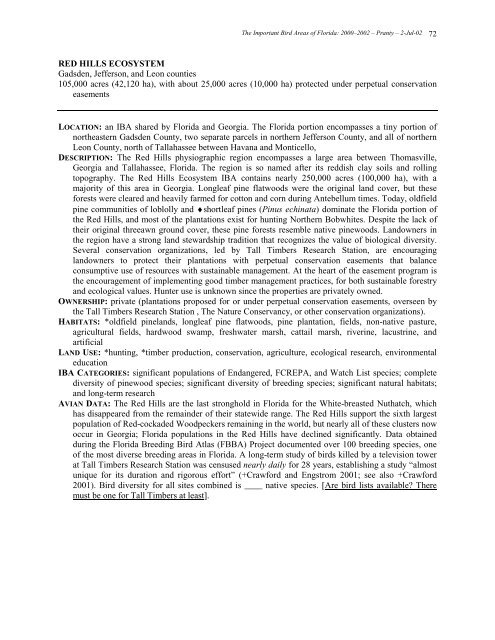The Important Bird Areas of Florida - National Audubon Society
The Important Bird Areas of Florida - National Audubon Society
The Important Bird Areas of Florida - National Audubon Society
You also want an ePaper? Increase the reach of your titles
YUMPU automatically turns print PDFs into web optimized ePapers that Google loves.
<strong>The</strong> <strong>Important</strong> <strong>Bird</strong> <strong>Areas</strong> <strong>of</strong> <strong>Florida</strong>: 2000–2002 – Pranty – 2-Jul-02 72RED HILLS ECOSYSTEMGadsden, Jefferson, and Leon counties105,000 acres (42,120 ha), with about 25,000 acres (10,000 ha) protected under perpetual conservationeasementsLOCATION: an IBA shared by <strong>Florida</strong> and Georgia. <strong>The</strong> <strong>Florida</strong> portion encompasses a tiny portion <strong>of</strong>northeastern Gadsden County, two separate parcels in northern Jefferson County, and all <strong>of</strong> northernLeon County, north <strong>of</strong> Tallahassee between Havana and Monticello,DESCRIPTION: <strong>The</strong> Red Hills physiographic region encompasses a large area between Thomasville,Georgia and Tallahassee, <strong>Florida</strong>. <strong>The</strong> region is so named after its reddish clay soils and rollingtopography. <strong>The</strong> Red Hills Ecosystem IBA contains nearly 250,000 acres (100,000 ha), with amajority <strong>of</strong> this area in Georgia. Longleaf pine flatwoods were the original land cover, but theseforests were cleared and heavily farmed for cotton and corn during Antebellum times. Today, oldfieldpine communities <strong>of</strong> loblolly and ♦shortleaf pines (Pinus echinata) dominate the <strong>Florida</strong> portion <strong>of</strong>the Red Hills, and most <strong>of</strong> the plantations exist for hunting Northern Bobwhites. Despite the lack <strong>of</strong>their original threeawn ground cover, these pine forests resemble native pinewoods. Landowners inthe region have a strong land stewardship tradition that recognizes the value <strong>of</strong> biological diversity.Several conservation organizations, led by Tall Timbers Research Station, are encouraginglandowners to protect their plantations with perpetual conservation easements that balanceconsumptive use <strong>of</strong> resources with sustainable management. At the heart <strong>of</strong> the easement program isthe encouragement <strong>of</strong> implementing good timber management practices, for both sustainable forestryand ecological values. Hunter use is unknown since the properties are privately owned.OWNERSHIP: private (plantations proposed for or under perpetual conservation easements, overseen bythe Tall Timbers Research Station , <strong>The</strong> Nature Conservancy, or other conservation organizations).HABITATS: *oldfield pinelands, longleaf pine flatwoods, pine plantation, fields, non-native pasture,agricultural fields, hardwood swamp, freshwater marsh, cattail marsh, riverine, lacustrine, andartificialLAND USE: *hunting, *timber production, conservation, agriculture, ecological research, environmentaleducationIBA CATEGORIES: significant populations <strong>of</strong> Endangered, FCREPA, and Watch List species; completediversity <strong>of</strong> pinewood species; significant diversity <strong>of</strong> breeding species; significant natural habitats;and long-term researchAVIAN DATA: <strong>The</strong> Red Hills are the last stronghold in <strong>Florida</strong> for the White-breasted Nuthatch, whichhas disappeared from the remainder <strong>of</strong> their statewide range. <strong>The</strong> Red Hills support the sixth largestpopulation <strong>of</strong> Red-cockaded Woodpeckers remaining in the world, but nearly all <strong>of</strong> these clusters nowoccur in Georgia; <strong>Florida</strong> populations in the Red Hills have declined significantly. Data obtainedduring the <strong>Florida</strong> Breeding <strong>Bird</strong> Atlas (FBBA) Project documented over 100 breeding species, one<strong>of</strong> the most diverse breeding areas in <strong>Florida</strong>. A long-term study <strong>of</strong> birds killed by a television towerat Tall Timbers Research Station was censused nearly daily for 28 years, establishing a study “almostunique for its duration and rigorous effort” (+Crawford and Engstrom 2001; see also +Crawford2001). <strong>Bird</strong> diversity for all sites combined is ____ native species. [Are bird lists available? <strong>The</strong>remust be one for Tall Timbers at least].
















